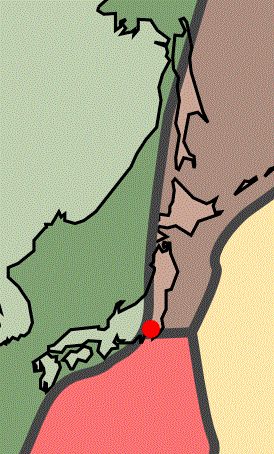Japan Quake/TsunamiNotice the ridges Japan is built on...
A "triple junction" in the seismology world is something like the phrase 'bewitching hour'. It means things are prone to happen here. The red dot in left map is the Boso triple junction, not too far from Tokyo. A triple junction is where three geologic "pieces" (plates, trenches) intersect. Note the similarity of their borders to the undersea ridges that Japan is literally built on. One of the trenches involved has a major quake every several decades, and none are less than magnitude 7+. The dots on right map represent 100 or so quakes in the first 48 hours after the Mar 11 Tsunami. The power plant in the news is at Sendai. Left map comes from Wikipedia. Right map comes from japanquakemap.com. Click either image. There are only a few triple junctions in the world. One is in Ethiopia, connected to the Mideast faulting. There are none near New Madrid.
 About 90% of the world's earthquakes and 80% of the world's largest earthquakes occur along the Ring of Fire. About 90% of the world's earthquakes and 80% of the world's largest earthquakes occur along the Ring of Fire.
It is a 25,000 mi horseshoe associated with a nearly continuous series of oceanic trenches, volcanic arcs, and volcanic belts or plate movements. The Ring of Fire has 452 volcanoes and is home to over 75% of the world's active and dormant volcanoes.
The big 9.0 quake off the Northern Japan coast Mar 11 would have taken about 14 minutes to travel through the earth to the central US. Several Midwest seismographs showed wild squiggles on that day. Wyandotte Cave is west of Louisville Ky. Compare its Mar 10 readings to the Mar 11 readings. For the latest real-time list of Japan quakes, type earthquake japan into a Google search box. Our days are now 1.6 microseconds shorter! Japan is now 13 feet closer to us! NY Times
|

